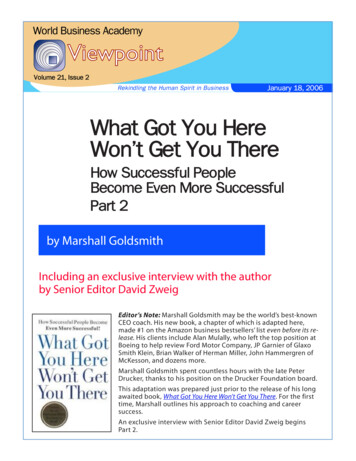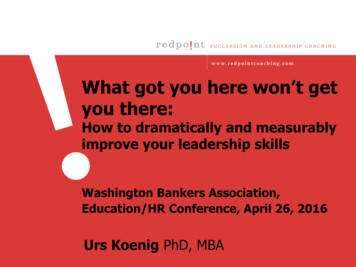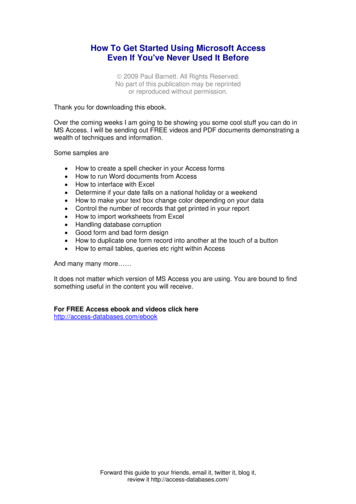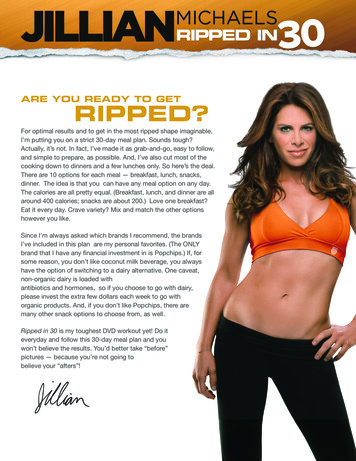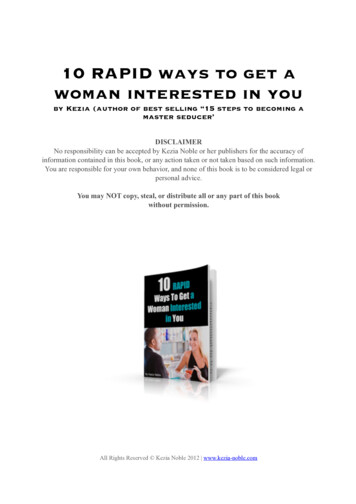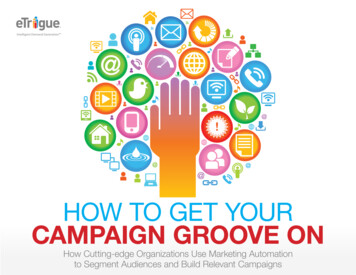
Transcription
Intelligent Demand Generation HOW TO GET YOURCAMPAIGN GROOVE ONHow Cutting-edge Organizations Use Marketing Automationto Segment Audiences and Build Relevant Campaigns
adNurturingSalesAccelerationWebinars, Podcastsand EventsReactivation—Revisiting the“Dead Pool”Promos andSpecial OffersRetentionand RenewalConclusionForewordDemand Center MarketingDigital marketing has transformed how mostorganizations market today. At the core of successfulmarketing organizations is the concept of a “demandcenter” enabled by marketing automation—one thatlinks marketing activity, and the customer buyingand sales processes to analytics that close the loopbetween investment and results. Not surprisingly,savvy marketers are embracing the concept.This e-book looks at seven types of campaignsthat can help you build successful demandgeneration programs.One of the foundational benefits of moving from a basic email marketing system to a marketingautomation solution is the ability to create, deliver and manage campaigns. The step up to anend-to-end marketing automation system enables marketers to graduate from batch-and-blastemails to building a true dialogue with their customers and prospects.Rather than simply sending out the same messaging to an entire database, marketing automationtools now make it easy for marketers to segment their audiences and build campaigns with relevantoffers based on the behavior and interests of targeted prospects.It is understandable that new adopters to marketing automation often start slowly with coreprograms that can be expanded over time. However, it is critical that marketers expand theirknowledge base to take advantage of the full features and functionalities of automation to reachprospects and move them through the sales funnel more efficiently by: Connecting the efforts of disparate teams, including sales and marketing Capitalizing on intelligence-driven reporting and data Streamlining personalization by automating follow up, and Automating repetitive business tasksAndrew GaffneyEditor, DemandGen ReportExample of a graphically basedemail message, part of aneducational event campaign.Intelligent Demand Generation 2
ForewordOverviewMarketingAutomationTable of ContentsForewordOverviewMarketing AutomationCampaignsMaximizing the First Touch Point withNew ProspectsSegmentationCampaign 1:Drip MarketingCampaign 2:Lead NurturingCampaign 3:Sales AccelerationCampaign 4:Webinars, Podcasts and EventsCampaign 5:Reactivation—Revisiting the “Dead Pool”Campaign ars, Podcastsand EventsReactivation—Revisiting the“Dead Pool”Promos andSpecial OffersRetentionand RenewalConclusionOverviewThanks to technology, the rules of engagement for sales and marketing teams are being rewritten.Marketing automation is now a part of the arsenal of tools available to make the sales process moreefficient. The capabilities go far beyond bulk emailing and the model of elementary email blasts.These automated systems now make it possible for companies to communicate to, track andrespond to prospects with laser-precise messaging based on their immediate and long-term webbehavior, responses to emails and the demographic profile that the prospect fits into. It’s possibleto segment prospects in new, multi-dimensional categories with precision, and to communicate theright message at the most appropriate time.And so with great power comes great responsibility—if you want to be successful at it, anyway. Thise-book helps you understand that power. We’ll show you what’s possible with marketing automationand illustrate a few different ways that you can get the most out of it.Campaigns are at the epicenter, and we’ll show you how easy it is to put them to work in a variety ofways for some pretty dramatic results. We’ll discuss seven representative campaigns that capitalizeon new automated marketing tools. And we’ll show examples of real-world execution that demonstratehow companies are speeding up the conversion of leads from prospect to customer.Let’s start with some basic concepts before we dive into how to get your campaign groove on.Promos and Special OffersCampaign 7:Retention and RenewalConclusionFast Fact43% of top performers are using marketing automation tools.Top performers are three times more likely to use marketingautomation than everyone else.—Gleanster ResearchIntelligent Demand Generation 3
adNurturingSalesAccelerationWebinars, Podcastsand EventsReactivation—Revisiting the“Dead Pool”Promos andSpecial OffersRetentionand RenewalConclusionMarketing Automation“Marketing automation replaces separatesystems for email, web visitor tracking, leadscoring, nurture campaigns, campaignmanagement and reporting with one solutionthat streamlines marketing processes andshares data with sales.”Marketing automation tools are empowering marketers to answer key questions, including:—David Raab, PrincipalRaab Associates“Marketing automation solutions offer new technology and processes that transform the waymarketers identify and engage prospective buyers through targeted outbound and inboundmarketing. By giving marketers more power to build and deliver targeted email campaigns,these solutions can accelerate buying cycles and improve conversion rates from inquiriesto qualified opportunities, to what we’re all after: closed sales. Who is my target audience? What is the best way to communicate with our prospects? How do we assess and nurture a non-responsive prospect?Marketing automation is essentially all thesame benefits you currently get from an emailCampaignsmarketing tool (which 87% of the marketWhy are campaigns so important? Campaigns are at the core of marketing automation. They’recritical to customer engagement because they represent the customer journey from initial contact toongoing loyalty. Campaigns are valuable for pure lead generation purposes, for qualifying prospectsand also as a method of segmenting your database to ensure targeted and relevant communication.currently utilize) with integrated web analytics,landing pages, business rules, and CRMintegration. The outcome is one system tomanage multiple channels, automation ofpersonalized engagement and transparencyinto marketing and sales performance.”—Ian Michiels, Principal AnalystGleanster ResearchIntelligent Demand Generation While automation systems make it possible to schedule a great variety and complexity of campaigns,it is also imperative not to fall into the “set and forget” trap.Winning campaigns may require a bit of a learning curve—composing effective content and schedulingsuccessful timing is a new discipline for many marketers. This e-book will walk you through someexamples that will help pave your way so you can get your campaign groove on in no time.4
adNurturingSalesAccelerationWebinars, Podcastsand EventsReactivation—Revisiting the“Dead Pool”Promos andSpecial OffersRetentionand RenewalConclusionQuestion:Maximizing the First Touch Point with New ProspectsWhen will announcements, newsletters,press releases and similar collateral be readand valued instead of tossed as spam?A harsh reality for BtoB organizations is that because of the power of technology, specifically theInternet, buyers are increasingly empowered to conduct their own research on their terms, and nolonger lean on sales representatives to provide the information they need. They are literally reservingtheir engagements for much later in the sales cycle—essentially when they are ready to buy.Answer:When both timing and content are strategic.Before marketing automation and its behaviortracking capabilities, it simply wasn’t possible touse types of collateral like this. Lack of relevanceand timeliness meant such messages wereconsidered spam. With automated marketing,which can tie prospect behavior to collateraldistribution, it’s a whole new world.Has a prospect increased activity on the website,downloaded more white papers, or otherwiseshown a jump in interest? Perhaps their painsuddenly got worse, and they are seekingimmediate solutions. What better time to sendan announcement or press release about anew customer case study who has solved theirchallenges with your solution or product?Perfect timing and the right message make foran unbeatable combination.This makes it more difficult to engage with prospects early in the cycle and, more importantly,be present and part of the decision-making conversation.The role of sales is still, of course, critical. However, the shift in buyer empowerment calls for a newfocus for sales and marketing—to be proactively involved in assessing buyer behavior and qualifyingprospects accordingly. This tactical way of thinking will help organizations more effectively developinitial engagements—even as they are happening further down the buyer’s research cycle.Converting prospects into qualified leads is the first concrete step toward a sale for marketing andsales organizations. Email marketing automation makes that step easier than ever with cutting-edgelead scoring tools that rank prospects based on key attributes, including: Level of engagement with the company Demographic profile Stage in the buying process Other factorsKey Campaign Considerations Use active/compelling subject lines Make sure the offer or call-to-action is strong Landing pages may benefit from visual elements that are consistent with the email offerIntelligent Demand Generation 5
adNurturingSalesAccelerationWebinars, Podcastsand EventsReactivation—Revisiting the“Dead Pool”Promos andSpecial OffersRetentionand RenewalConclusionSegmentationAs with any marketing campaign strategy, it’s important not to subscribe to the one-size-fits-allapproach. Who are you speaking to and what interests them?Fast FactSegmentation is essentially theidentification of subsets ofbuyers within a market that sharesimilar needs and demonstratesimilar buyer behavior.—marketingteacher.comAutomated marketing makes it easier to segment customers across a number of dimensions, includingdemographics, job function, title and interests, among others, and look at their prior activities andthe length of their prior engagements. You’ll often hear the term “personas” used interchangeablywith segments, and that’s true up to a point. Personas look at who your audience is and can helpyou understand what interests them. Segmentation takes you a step further by adding the additionaldimension of their online interaction history with your site and with your email campaigns.Once you’ve decided who you want to campaign to, targeting the right audience segmentis easy with the simple search based profiling built into marketing automation systems.Marketers can quickly build a target audience based on any information, including title, geography,job function, visit frequency or topic of interest.Key Campaign Considerations Ensure that data is up-to-date and fresh Include key words and phrases that relate to the vertical industry or functional role Make it obvious that the campaign is directed to a specific segment or functional roleIntelligent Demand Generation 6
dience SegmentationWith so much data available these days,marketers must be smart in deciding exactlyhow to segment and target their audience toachieve the best return on investment. Becausebuyers are increasingly empowered, the demandfor personalization and an enhanced userexperience is a key decision driver. There areinfinite ways to divide and target an audience.The rationale for segmenting is to target anaudience according to what they need; how theyacquire the solution to the need; and what willdeliver the best ROI from marketing.LeadNurturingSalesAccelerationWebinars, Podcastsand EventsReactivation—Revisiting the“Dead Pool”Promos andSpecial OffersRetentionand RenewalConclusionThe key to successful campaign email marketing is to target with relevant content. Creating severaltreatments and testing several versions of content and subject lines lets you measure results andmake changes to optimize campaigns for the best possible outcome.Simple drag-and-drop tools make it easy to quickly build target audience lists based on any information, including title,geography, job function, activity, visit frequency or topic of interest. Lists may be static or dynamic.Fast FactIn a recent study of more than 20potential customers sixmillion leads, results indicated that contactingtimes is the ideal way to maximize conversion rates withoutovertaxing staff resources.Intelligent Demand Generation 7
adNurturingSalesAccelerationWebinars, Podcastsand EventsReactivation—Revisiting the“Dead Pool”Promos andSpecial OffersRetentionand RenewalConclusionCAMPAIGN 1:Drip MarketingIntelligent Demand Generation 8
adNurturingSalesAccelerationWebinars, Podcastsand EventsReactivation—Revisiting the“Dead Pool”Promos andSpecial OffersRetentionand RenewalConclusionDrip MarketingLike a drip of water from an irrigationsystem, drip marketing sends, ordrips, a specific set of email messagesto prospects on a timed basis.Key Campaign Considerations Timing and cadence are key; decideon a frequency of communicationand stick to that cadence Map drip marketing messagingto the prospect journey to ensurethat relevant information is sentat the right timeEmail campaigns are one of the most cost effective ways to engage prospects. To engage prospectsand customers over time and on their terms, marketers utilize drip marketing techniques to sendprepared messages through email or other media to customers or prospects gradually. The contentthat is sent is determined by their segmentation profile. This ultimately helps marketers develop agr
—marketingteacher.com Key Campaign Considerations Ensure that data is up-to-date and fresh Include key words and phrases that relate to the vertical industry or functional role Make it obvious that the campaign is directed to a specific segment or functional role

